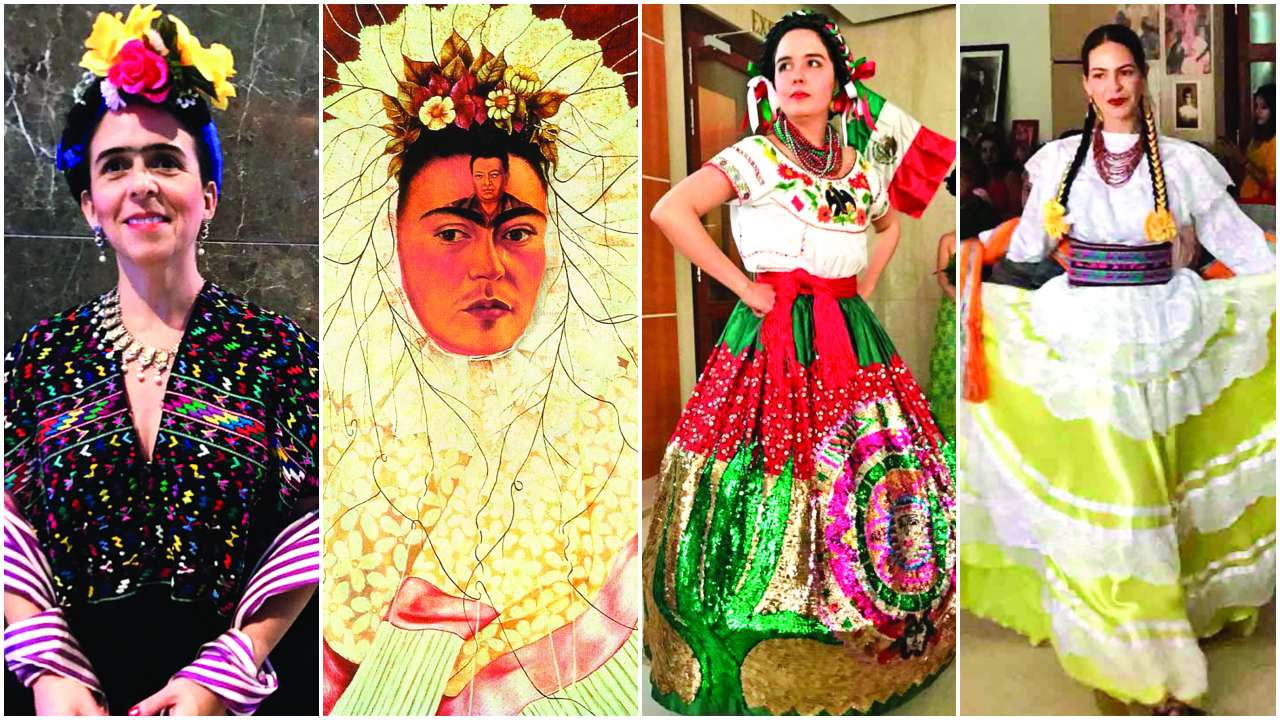
Frida Kahlo painted all manner of things – landscapes, still-life, people – in her lifetime, but it is for her self-portraits that she's best known. Over one-third of her oeuvre is taken up by these 'selfies', most of which are characterised by an expressionless face staring out of the canvas, strong, sinewy features marked by the trademark unibrow, full lips – the downy over it clearly visible, and upswept hairdo decked with elaborate braiding, or veils, or ornaments. In several of these, viewers can see the dress she wears, most often traditional Mexican garments such as the huipil, a kind of loose-fitting blouse or tunic, paired with long, flared skirts called enaguas trimmed with holan or flounces, and rebozos or fringed shawls wound around her torso.
"Frida's paintings are a very good introduction to the traditional textiles of Mexico," says Raquel Mansur Saenz, a textiles collector from the Latin American country, who was in Delhi late last month to present a unique fashion show that gave Indian audiences a glimpse of the diversity of Mexico's textile traditions through the paintings and the persona of Frida Kahlo. The event, a fundraiser organised by the capital's expat community to raise money for a shelter home in old Delhi, had models parading garments, very like the ones seen in Kahlo's paintings, accompanied by music from the region they originate from, with snapshots from Kahlo's life.
"The geometric motifs, for example," Saenz says, pointing to the embroidery on a blouse, "is of Mayan origin. The feather-woven square in this one signifies that the woman is the mother of sons." Often, she adds, styles of embroidery, symbolism, colours change from region to region, revealing an incredible diversity of expression, much of which, she rues, is now lost. Kahlo, says Saenz, was very aware of Mexico's diverse costumes, and had acquired pieces from various parts of the country. "She was especially fond of the styles worn by women of the Zapotec tribe in Tehuantepec province," says Saenz, looking up an image of Kahlo's famous painting, 'Self Portrait as a Tehuana', where she can be seen wearing an elaborate ruff, the huipil grande, around her face.
"Kahlo's fondness for indigenous clothing reflected her admiration for artisan traditions, and her commitment to her native Mexico, where distinctive styles of dress in Oaxaca and other regions are intimately linked with cultural identity," writes Mexican textile specialist Chloë Sayer in an essay that accompanies the exhibition, 'Frida Kahlo: Making Her Self Up', that opened yesterday at London's famed Victoria & Albert Museum (V&A). The five-month long show displays a selection of Kahlo's clothes, cosmetics, paintings and photographs, all taken out a few years ago from a locked up bathroom in her home, La Casa Azul, now a museum, where they had been put by her husband, the muralist Diego Rivera, after her death.
There's also a 2016 book on the subject, 'Frida Kahlo: Fashion As the Art of Being', revealing how Kahlo fashioned her image with her choice of clothes and accessories, transforming them into a disruptive aesthetic attitude that underlined her gender identity, but in a way that was all her own.
Frida has always been something of a style icon, as art historians well know. She was on the cover of the French edition of Vogue magazine in 1939, and elements of her style, such as the flower crown, braids, chunky jewellery, and corsets, have inspired numerous style icons and designers – Jean Paul Gaultier, Dolce & Gabanna, Madonna, Rihanna, et al – over the decades. Earlier this year, British prime minister Theresa May was seen wearing a bracelet with images of Frida and French designer Roland Mourter's February 2018 ramp show channeled Frida, especially the corsets she wore after an accident damaged her spine. There's even been a book on the subject 'Frida Kahlo: Fashion As the Art of Being', revealing how Frida fashioned her image with her choice of clothes and accessories, transforming them into a disruptive aesthetic attitude that underlined her gender identity, but in a way that was all her own.